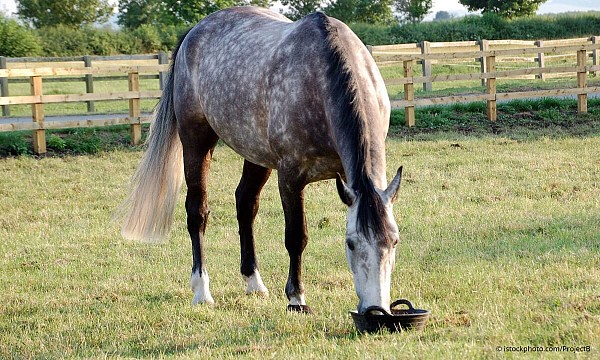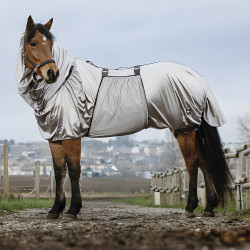The advantages of keeping a horse at grass is that it is more natural, especially if horses are kept at grass as a group, the risk of behavioural problems occurring are less than with a stabled horse, general daily care is less time consuming without the need to muck out stables, etc and costs are lower without the need to provide bedding and hay each day. However there are also disadvantages as the grass kept horse will be out in all weather conditions and will require greater preparation for riding if wet and muddy.
Although the daily care needed for a horse kept at grass is less, the horse should be checked at least twice daily for signs of ill health and any signs of injury and regular maintenance is also needed of the grazing pasture. The maintenance and management of the pasture is an important part of the care of the horse kept at grass to ensure safety, adequate containment, continual good quality grazing and the lack of poisonous plants. For horses kept at grass on a livery yard regular checks, the maintenance of fencing and fields, etc is carried out by the yard but for those keeping a horse at home or in a rented field it is important to consider the need for regular checks on the horses as well as the pasture management and maintenance that will be needed.
Any grass kept horse should have a sheltered area available. A sheltered area will provide protection from winds, rain or snow in the winter and relief from the heat of the sun in summer. Shelters can either be man-made or natural shelter can be provided by hedges and trees.
Many horses kept at grass thrive well during the summer on grass alone but as the grass subsides during the autumn and winter months hay will need to be fed daily to compensate for the lack of grass available and concentrate feed may also be required during the colder months. During particularly dry summers the grass can become sparse as it dries out and growth slows and so hay may also need to be fed during long hot summers.
During the spring the grass available is lush and although not a problem for most horses it can cause obesity and some horses and ponies may also suffer from Laminitis. Therefore restricted access to grass may need to be considered. This can be achieved by putting a grazing muzzle on the horse without the need to move the horse or moving the horse to a pasture with less grass, or fencing off a portion of the field to provide a starvation area.
Water should always be available and checked regularly. The best way to provide water in pastures is with a water trough that refills automatically from a water source by way of underground pipes. During the winter water can become iced over and it will be necessary to break the ice covering the water at least twice a day to allow the horses access to the water and if water in the pipes of an automatic refilling system become frozen the water troughs will fail to refill as the water is drunk and so will need to be refilled manually as the water level drops. If no automatic watering system is in place, water can be provided in buckets or troughs and refilled manually. Traditional buckets should have handles removed to avoid the potential for a horse horse to get a leg caught in the event it knocks a bucket over. During the summer months when horses drink more, without a manual refilling system, more water will need to be made available.
All fencing should be adequate and safe. Walls and post and rail fencing are effective and safe. Thick strong hedges provide suitable containment and also act to provide shelter from the wind but may become damaged by horses over time rendering them less effective. Electric Fencing can also be used alone or in combination with fencing or hedges to provide more secure fencing. Barbed wire is not recommended as this can cause minor injuries and scratches and occasionally more serious injuries. Any fencing should be regularly inspected for damage and repaired promptly as and when necessary.
Horse trample down, pull up and destroy much of the grass in the field and over time grass can become sparse and heavily stained with droppings. During winter particularly the ground can become muddy, churned up and bare. Therefore regular maintenance is needed of the field such as removal of droppings, harrowing, rolling, fertilising and re-seeding to ensure continual adequate grazing.














